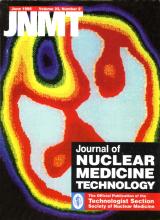Abstract
Objective: This case report identifies the sources of an incorrect computer-assisted renogram analysis.
Methods: A 74-yr-old male patient with a history of transitional cell bladder carcinoma resulting in radical cystectomy and ileal conduit construction presented with deteriorating renal function. The patient was known to have congenital absence of the right kidney, but this kidney was presumably identified by diuretic renography. Furosemide renography with 99mTc-MAG3 was performed to assess obstructive uropathy and overall renal function.
Results: Diuretic renography and region of interest (ROI) analysis appeared to demonstrate the presence of a right kidney. The images obtained from the study demonstrated a markedly dilated left renal pelvis that was misidentified as a right kidney because of size and shape similarities.
Conclusion: This case report demonstrates the importance of anatomic identification in the construction and analysis of renal scintigraphic images. It also demonstrates the importance of patient history to the overall evaluation of scintigraphic imaging.







